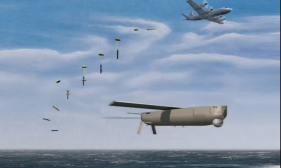Sonobuoy
India and the United States announced cooperation on co-production of U.S. sonobuoys for undersea domain awareness (UDA) for the Indian Navy, a high-end technology that allows tracking submarines in the deep seas and oceans.
| Overview |
|---|
 |
| First Used: Second World-War
Type: Small and Expendable Devices Uses: Underwater detection |
About Sonobuoy
- These are small, expendable devices used in underwater acoustics and sonar systems to detect and track submarines and other underwater objects.
- First used during the Second World War to detect German U-boats.
- Core-technology and dropped from aircraft or ships for anti-submarine warfare or underwater acoustic research.
- When floating on the water, it has both a radio transmitter above the surface and hydrophone sensors underwater.
- A typical sonobuoy consists of a cylindrical or spherical buoyanthousing, sensors for detecting acoustic signals, a battery or power source, and a radio transmitter or other communication system to relay data to the host platform (e.g., aircraft or ship).
- The advancement in sonobuoy technology aided the development of aircraft such as the P-2 Neptune, S-2 Tracker, S-3B Viking and P-3 Orion for anti-submarine warfare.

Key Features
- Helps to track potentially hostile submarines operating in the open ocean and in coastal areas.
- Information from these systems can help enable precision attacks with air-launched torpedoes.
- Used for scientific research and environmental studies, including studying the behavior of whales and other marine creatures.
Types
- Passive – It silently emits sound energy (pings) into the water and listen for the returning echo before transmitting any information, usually range and bearing via UHF/VHF radio to a receiving ship or aircraft. It uses a hydrophone to listen for sound energy from a target.
- Active – It emit a sound pulse and analyze the return signals (echoes) to detect and locate targets. It rather listen, waiting for sound waves (for instance, power plant, propeller or door-closing and other noises) from ships or submarines, or other acoustic signals of interest such as a crashed aircraft’s black box Pinger, to reach the hydrophone. It uses a transducer to send an acoustic signal.
- Special Purpose – It provide information about the environment, such as water temperature, ambient noise level, etc. It relay various types of oceanographic data to a ship, aircraft, or satellite. There are three types of special-purpose sonobuoys in use today that are Bathythermobuoy (BT), Search and rescue (SAR) and Air transportable communication (ATAC) and down-link communication (DLC).
